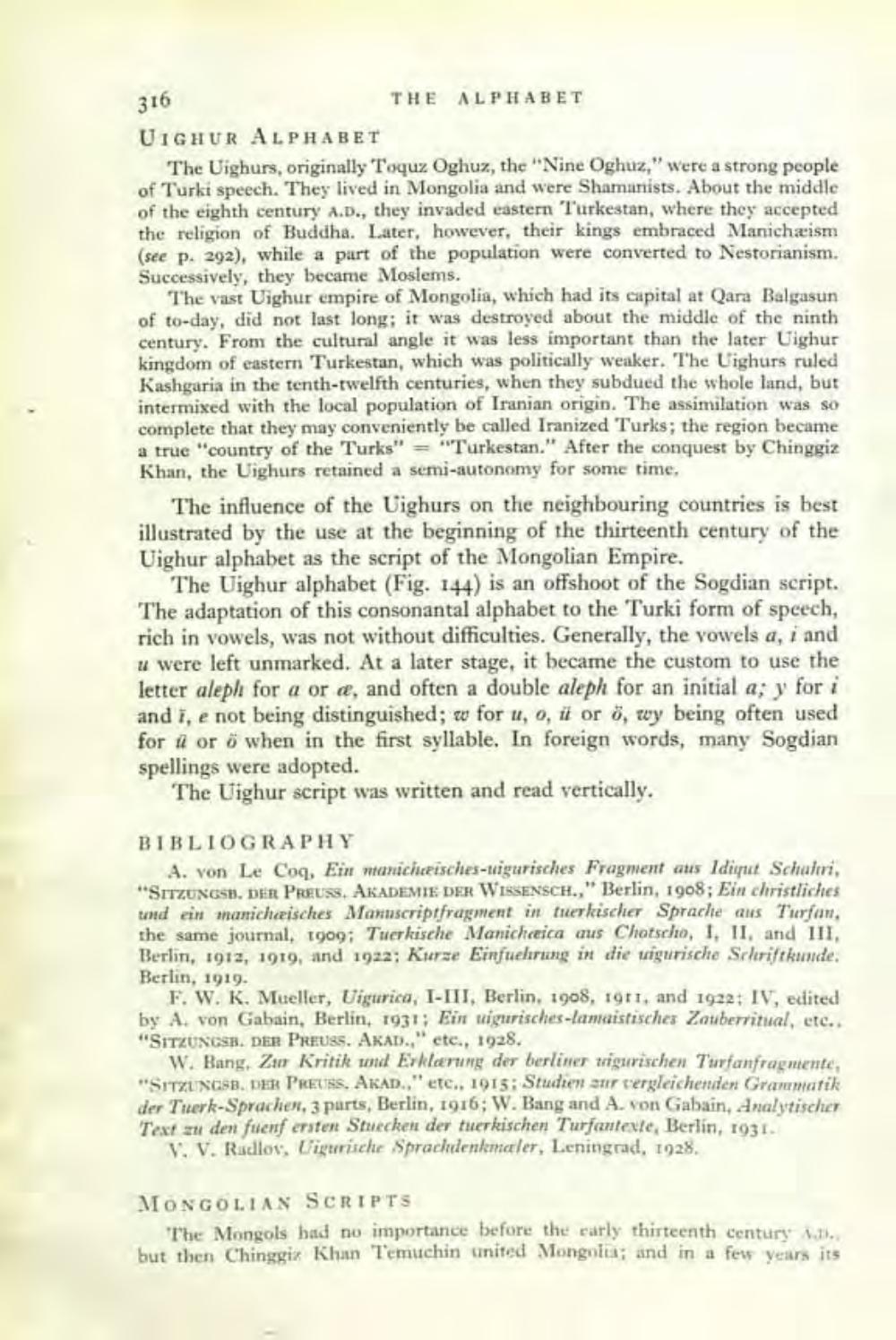________________
316
UIGHUR ALPHABET
The Uighurs, originally Toquz Oghuz, the "Nine Oghuz," were a strong people of Turki speech. They lived in Mongolia and were Shamanists. About the middle of the eighth century A.D., they invaded eastern Turkestan, where they accepted the religion of Buddha. Later, however, their kings embraced Manichæism (see p. 292), while a part of the population were converted to Nestorianism. Successively, they became Moslems.
The vast Uighur empire of Mongolia, which had its capital at Qara Balgasun of to-day, did not last long; it was destroyed about the middle of the ninth century. From the cultural angle it was less important than the later Uighur kingdom of eastern Turkestan, which was politically weaker. The Uighurs ruled Kashgaria in the tenth-twelfth centuries, when they subdued the whole land, but intermixed with the local population of Iranian origin. The assimilation was so complete that they may conveniently be called Iranized Turks; the region became a true "country of the Turks" "Turkestan." After the conquest by Chinggiz Khan, the Uighurs retained a semi-autonomy for some time,
THE ALPHABET
The influence of the Uighurs on the neighbouring countries is best illustrated by the use at the beginning of the thirteenth century of the Uighur alphabet as the script of the Mongolian Empire.
The Uighur alphabet (Fig. 144) is an offshoot of the Sogdian script. The adaptation of this consonantal alphabet to the Turki form of speech, rich in vowels, was not without difficulties. Generally, the vowels a, i and u were left unmarked. At a later stage, it became the custom to use the letter aleph for a or a, and often a double aleph for an initial a; y for i and i, e not being distinguished; w for u, o, it or ö, wy being often used for i or ö when in the first syllable. In foreign words, many Sogdian spellings were adopted.
The Uighur script was written and read vertically.
BIBLIOGRAPHY
A. von Le Coq, Ein manichaeisches-uigurisches Fragment aus Idiqut Schahri, "SITZUNGSB. DER PREUSS, AKADEMIE DER WISSENSCH.," Berlin, 1908; Ein christliches und ein manichæisches Manuscriptfragment in tuerkischer Sprache aus Turfan, the same journal, 1909; Tuerkische Manichaeica aus Chotscho, I, II, and III, Berlin, 1912, 1919, and 1922; Kurze Einfuehrung in die uigurische Schriftkunde. Berlin, 1919.
F. W. K. Mueller, Uigurica, I-III, Berlin, 1908, 1911, and 1922; IV, edited by A. von Gabain, Berlin, 1931; Ein uigurisches-lamaistisches Zauberritual, etc.. "SITZUNGSB. DER PREUSS. AKAD.," etc., 1928.
W. Bang, Zan Kritik und Erklärung der berliner uigurischen Turfanfragmente, "SITZUNGSB. DER PREUSS. AKAD.," etc., 1915; Studien zur vergleichenden Grammatik der Tuerk-Sprachen, 3 parts, Berlin, 1916; W. Bang and A. von Gabain, Analytischer Text zu den fuenf ersten Stuecken der tuerkischen Turfantexte, Berlin, 1931.
V. V. Radlov, Uigurische Sprachdenkmaler, Leningrad, 1928.
MONGOLIAN SCRIPTS
The Mongols had no importance before the early thirteenth century wa but then Chinggis Khan Temuchin united Mongolia; and in a few years its




